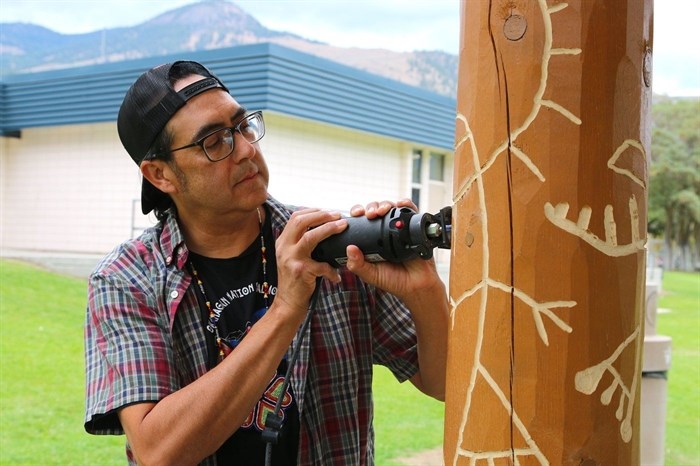
A Similkameen artist carves pictographs into outdoor class to ‘indigenize’ the school.
Image Credit: Athena Bonneau, Local Journalism Initiative
September 30, 2021 - 7:00 PM
Similkameen artist and teacher Míwlna (Les Louis) is carving pictographs into an outdoor classroom at Similkameen Elementary School as a way of Indigenizing the school grounds.
Míwlna (which means “in the middle of it all” in nsyilxcen, the syilx language) is the nsyilxcen language teacher at the school.
“I want my Indigenous students to be able to recognize that their identity and their culture is being recognized and valued so they can relate to that in a way to feel comfortable coming to school,” says Míwlna, who is from the Lower Similkameen Indian Band.
He’s carving pictographs of the Four Food Chiefs — Black Bear, King Salmon, Bitterroot and Saskatoon — into 10-foot poles, which support an outdoor log classroom installed in front of the school last year.
“The Four Food Chiefs comes from our captikwl (oral history). That’s how our knowledge was passed on from generation to generation,” he says.
The Four Food Chiefs are the cultural keystone species for the Okanagan/syilx people, says Míwlna. If they collapse, that means their whole ecosystem will collapse.
Míwlna says that according to syilx captikwl, the Four Food Chiefs were on this land before people and they sacrificed themselves for the people they knew were coming.
“I’ll lay to lay my life down and give all of my parts for the people to be to use,” they decided, as told in the stories, and their expectation was that people would “give thanks and make offerings” in return for this sacrifice, he says.
“I wanted to put the Four Food Chiefs on each pole because I think [it’s] pretty significant to have that here in an educational place of learning, to represent that everything we need is right here.”
Míwlna says his artwork is inspired by his culture, traditions, and captikwl. He’s also influenced by his art teacher, Mr. Carelse — who still works as the art teacher at Similkameen Elementary School.
‘Be an artist’
“I still remember what he wrote in my yearbook. It was really simple, but it was just: 'Be an artist.' That’s always in the back of my head … whatever creative thing that I’m working on, I’m always working to be an artist,” he says.
Naryn Searcy is the school’s principal.
“Louis is a very well-known and respected artist,” says Searcy.
“It just made sense to ask him if he would be willing to do some of his carvings on the school … He’s only just begun, but we just think it’s going to add a wonderful element to the space that our students use every day.”
It’s all part of Similkameen Elementary’s efforts to “decolonize the school and Indigenize their curriculum,” says Searcy.
While she hopes “all of society is trying to work towards reconciliation,” she says educators have a specific role to play in acknowledging “the traumatic history that Canada has imposed on Indigenous Peoples.”
In December 2015, The Truth and Reconciliation Commission of Canada (TRC) spoke to the responsibility to turn things around in its final report and 94 calls to action.
The TRC called upon “the federal, provincial, and territorial governments, in consultation and collaboration with Survivors, Aboriginal peoples, and educators” to “provide the necessary funding to Aboriginal schools to utilize Indigenous knowledge and teaching methods in classrooms.”
More broadly, they called on the federal government to draft new Aboriginal education legislation with the full participation and informed consent of Aboriginal people,” and to back this legislation with funding to support (among other things) the development of “culturally appropriate curricula.”
Searcy says schools need to be more reflective of Indigenous cultures and ways of knowing and being.
“So students see themselves and their culture and feel valued and like they belong in our school environment,” she says.
These carvings can also prompt non-Indigenous students to learn more, she says.
Míwlna says he’s carving in his free time after school, and he hopes to complete two of six poles within the next couple of weeks.
“I want to get this complete before the snow flies, and I’m excited to get this done because this will be my first time having something permanent in the school for my children to see,” he says.
— This story was originally published by The Discourse and IndigiNews.
News from © iNFOnews, 2021